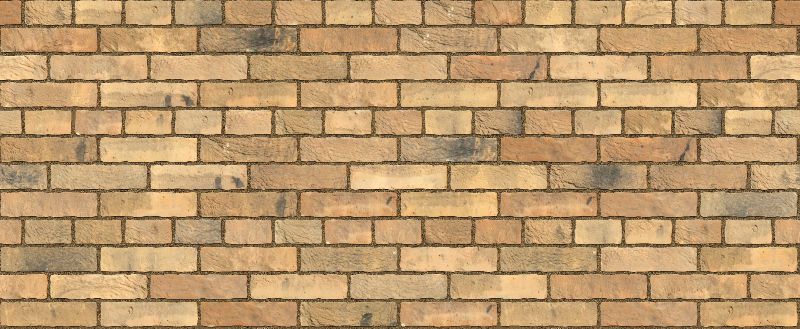London Stock Brick Common
Category
Brick
Download
Edit
London stock bricks possess a period appearance, emulating traditional London bricks with a fine buff-yellow base and authentic ‘coal spotted’ finish. London stock bricks are largely still handmade, using traditional techniques to exercise control over and replicate the surface finish and colours. Distinctive and bold, the yellows are resultant from the chemicals in lime-based clays, which were common to and locally sourced from London and the surrounding Thames Valley area, turning creamy-yellow, sandy or golden when fired. Black ‘coal spots’ are evident throughout this texture, likely a product of excess moisture, a result of sourcing the clay from in or near the river, appearing when the clay is fired in its mould. The excess moisture has created patches of different shades of yellows, oranges and reds, with air bubbles and other specs creating a textured surface. Sporting a slightly weathered appearance, which will help bed the material into its historic urban surroundings, it has a sand creased finish, which involves spraying sand onto the brick before it is fired, resulting in small ridges and shelves, creating a semi-rough, uneven, random texture much like a natural rock face, wave- or cloud-like formations. Reclaimed London stock bricks also tend to have coal spots or areas of discolouration, normally due to the atmospheric pollution from their use on buildings situated in heavily populated, vehicle-dense areas of the city.
Stock simply refers to the brick being particularly commonly manufactured and used in a certain region. London stock bricks became synonymous with the vernacular of Victorian era London architecture due to the abundance of locally sourced lime-based clay from the Thames Valley, and are often reclaimed from demolished buildings for new projects in the city, maintaining their popularity and widespread use. Lime mortar was commonly used with London stock bricks as it was the most abundantly and locally available bonding agent. Being weaker than modern mortar, it is easier to remove from reclaimed bricks, simplifying the repurposing process to allow the bricks to be redeployed on new projects.
Bricks are one of the most common materials in architecture and construction. With recorded uses dating back over 9000 years, brick traces its origins to mud and straw adobe blocks as found in Africa, southern Asian and southern American regions where hot, dry climates quickly dried and cured the earth bricks naturally in the heat. Clay bricks were used extensively throughout the Roman Empire thanks to the Romans’ invention of the mobile kiln, an innovation on the kiln used by ancient Egyptian builders to fire clay mixtures when placed in moulds, which enabled brick manufacture across Rome’s territories, using an increased range of local clay and soil compositions. Bricks were then regularly used in Europe from around the 12th century, when northern European countries traded materials, knowledge and design ideologies with Italy during the Gothic and Renaissance eras, spreading the use of Roman designs and construction methods, until dying out for a period due to bricks’ inability to recreate the intricate shapes of ornament and decoration associated with these styles.
The exploration of new forms and manufacturing methods seen a return to popularity, combined with their increasingly popular reputation as a replacement to timber in densely populated cities in the 17th century, particularly London, due to their far superior fire retarding properties, following a spate of particularly serious, destructive urban fires that ripped through older timber building stock. Other cities followed suit during the 18th century industrial revolution as bricks proved a hardy, enduring, cost effective, simple to construct, reliable, impervious, consistently dimensioned building unit protecting against damp air and wet ground conditions, especially after the invention of fast, mass manufacturing techniques. Brick was then popularised in northern America and other English, Belgian, Dutch, French, Spanish and Portuguese territories, through early émigrés taking their masonry skills abroad.
They remain popular due to their readily available raw materials, simple manufacture, low cost, ease of maintenance, basic-skilled assembly and attractive variety of colours, textures and finishes. Modern brick can be cut to standard sizes to form a versatile, durable building product, or specially manufactured to suit a variety of angles, curves and unique shapes for decorative purposes on organic forms. Hard-wearing and with excellent structural and thermal properties, they are a popular, efficient, human-scaled material for paving, load-bearing walls, cladding systems, landscaping and interior decorative walls, while a variety of finishes and palettes within the one product can create rustic, weathered, industrial aesthetics increasingly popular in bespoke, contemporary domestic, hospitality and workplace environments; practical, perfunctory settings; or decorative façades. Preferred for their domestic, human scale, bricks are one of the easiest construction materials to handle and build with when combined and laid with cementitious mortars. They are well suited to domestic, care, primary education and community building types in all climatic settings provided they are manufactured correctly and to the right specifications with respect to their locale.
London stock bricks are primarily used in contemporary circumstances to match original brickwork in repair and restoration work on heritage projects, or for extensions, renovations and new builds in conservation areas to sensitively and respectfully tie in to its rich, historic surroundings. Its bright, vibrant and distinctive colouring can also be used in harmony with both dark and light natural materials and concretes, or used as a highlight colour against a more neutral, less expressive brick.
A seamless brick texture with london stock brick arranged in a common pattern. Seamless textures can be tiled repeatedly across a surface without visible seams making them useful for architectural drawings and 3D models. This image can be used as a SketchUp texture, Revit material or imported into Photoshop for use in 2D illustrations. A high resolution version of this texture is available, as well as CAD hatches and PBR maps with Architextures Pro.

